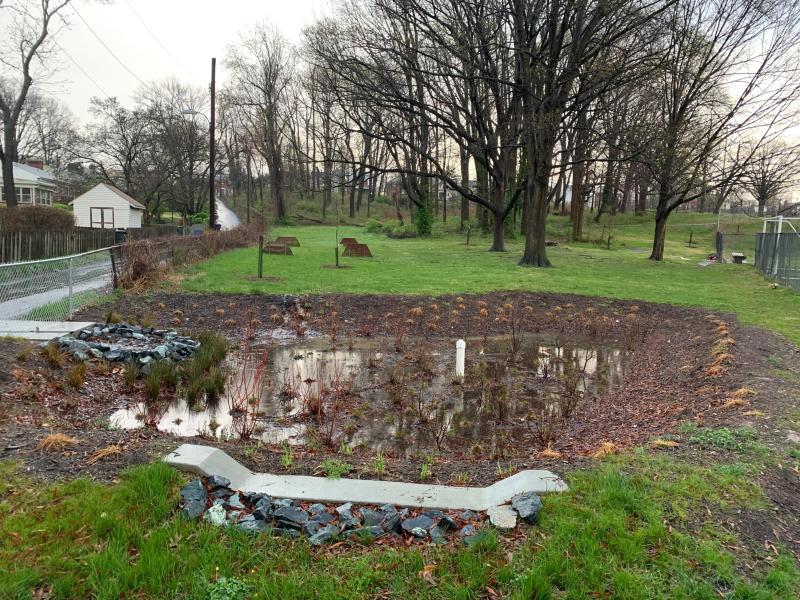<< Back to Innovative Stormwater Retrofits main page

The Fort Stevens Recreation Center stormwater retrofit project aims to mitigate the impacts of historic development on the Fort Stevens Recreation Center site.
The Fort Stevens Recreation Center is an 8-acre site in northwest Washington with almost 2 acres of impervious area from rooftop, parking lot, pathways and tennis and basketball courts. These hardscapes installed on the upslope portions of the site along with the absence of stormwater management controls were creating drainage problems leading to impacts including a soggy athletic field at the lowest portion of the site and erosion of hillside soils threatening the existing, mature tree canopy on the site and resulting in large amounts of sediment deposition on the courts and playgrounds.
The goal of this project was two-fold:
- To reduce, filter and control the stormwater runoff being generated by the site and,
- To protect the mature tree canopy on the site from further impacts due to uncontrolled stormwater and poor development practices.
This project included the installation of two stormwater best management practices (BMPs) to capture and treat stormwater runoff from the existing impervious hardscapes prior to conveyance into the storm sewer system, the Potomac river and ultimately the Chesapeake Bay. These stormwater management practices called “Bioretention” are vegetated systems that mimic the natural environment to reduce stormwater volumes and pollutants for the purpose of restoring our streams and rivers.
A bioretention provides the following benefits:
- Reduces stormwater runoff
- Slows stormwater flows
- Removes stormwater pollutants
- Provides habitat for birds, bees, and other pollinators
- Improves air quality
- Reduces air temperatures
By capturing stormwater and by treating the pollutants stormwater carries, a bioretention helps protect and restore our streams and rivers.
Additionally, minor site repairs were also conducted to ensure that stormwater will flow appropriately into the existing infrastructure on the site. This included small spot repairs to raise the curb around the tennis courts, reconfigure the fence line and storm drain to ensure stormwater is captured and not spilling over and down the hillsides (taking much needed sediment with it!). The project also included erosion control measures to protect the existing mature canopy trees on the two hillsides of the site.
How is a Bioretention Maintained?
Routine maintenance is necessary for all stormwater management practices. Routine maintenance for a bioretention includes cleaning out the inlets to ensure that stormwater can get into it, making sure overflows are free and clear of debris so that they can function during larger storm events, sustaining the vegetative cover by weeding/mowing/pruning as needed.
Project Status: This project is now complete.
Final Designs

